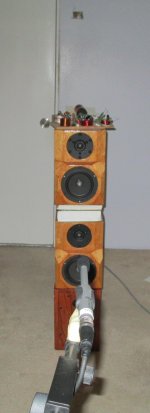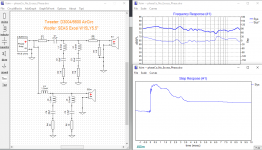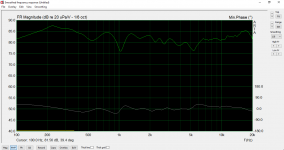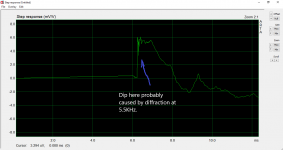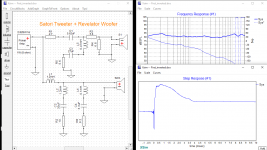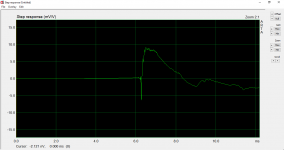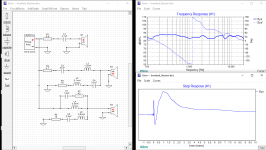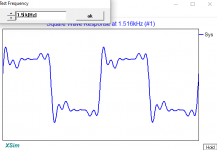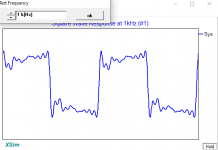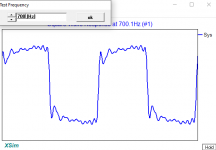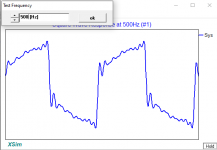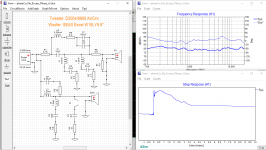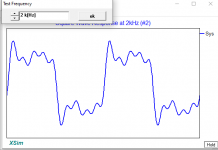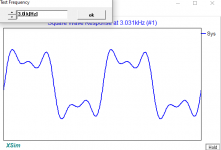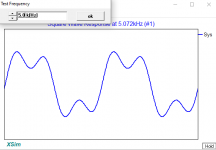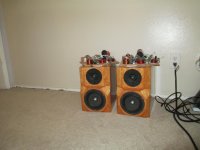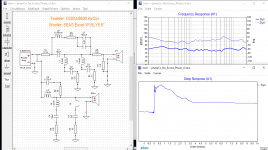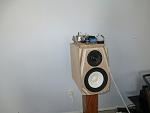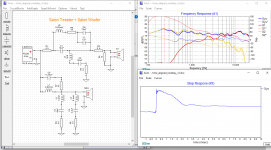Andy, you never defined your used terms. I'm not sure they are "industry standard". Maybe you would like to state them. They seem a bit overlapping to me... as they both use "time"..
# Time-Phase Coherence
# Time coincidence
//
PS. Aha, maybe Duelund was at B&O at the time?
# Time-Phase Coherence
# Time coincidence
//
PS. Aha, maybe Duelund was at B&O at the time?
I've been doing some simulation on how to convert a regular speaker to time-phase coherent. The software is Xsim which has enough basic stuffs for basic simulation.
But first let's get some terminology out of the way. The definitions use freq. and phase response so there won't be any ambiguity. I am sure different people might have different terminologies but with respect to what I did, here are three types of first order speaker, from easiest to hardest.
Here are three:
1. First order/No Time-Phase coherence: this speaker will use first electrical order, but there is no time-phase coherence. It will not be able to produce a proper step response. It's more or less conventional with the exception that it uses first order filters.
2. First order/Time-Phase Coherence, BUT NO "Time coincidence"
(which will be explained in #3).
This speaker will be able to produce a proper step response, BUT and an important BUT. It may not be able to produce an excess phase of 0 degree from say 50Hz to 20KHz. This means that the speaker, for example, may have a phase shift of 50 degree or more or could be a full 360 degree at 15KHz, but only 5 deg at 500Hz. That is its excess phase will vary especially at higher frequencies as the tweeter approaching 20KHz. John Atkinson would agree this speaker meets his definition of "Time-Phase Coherence" since it could produce a proper step response. My guess is most speakers that were measured by John Atkinson would fall into this category. I've seen some measurements done on Vandersteens speakers and I was like ... hmmm... I am not quite sure. But the most stringent definition is reserved for #3.
3. First order/Time-Phase Coherence AND Time-coincident: this is the most difficult definition for any speaker to meet. That is it has to be able to produce a proper step response like in #2, BUT it also has to be able to have a 0 degree of excess phase from 1Hz - 20KHz. In reality, no speaker will have absolutely 0 degree, but the variations should be very small. I believe Thiel claims that their speakers excess phase shift is only a few degrees (less than ten). To be honest, I am not sure many speakers in the entire history can meet this definition.
So to summarize, you have three distinct possibilities from easiest to hardest:
1. First order/No Time-Phase coherence
2. First order/Time-Phase coherence BUT NO "Time coincident"
3. First order/Time-Phase coherence AND "Time coincident" (the most stringent)
Excess phase is a manifestation of a pure time delay. It is irrelevant since once the wave form is launched bt a speaker there will be a propagation delay to the observation point (mic, listener, etc).
A truly Time and phase coherent speaker, DC to light, will have an excess phase response given as Phi(f) = 2Pi x f x Td where Td is the time delay between source and observation point.
Time coincident is meaning less. It appears to mean zero phase. If a speaker is time and phase coherent then it must be either linear phase or zero phase, relative to some reference position. Any linear (excess) phase component can be removed by changing the reference point rendering it time coincident. Thus, any time and phase coherent speaker must also be time consistent relative to some reference point. That reference point is the effective source of the sound wave.
Regardless of the crossover, the low and high frequency cut offs of the speaker mean that even if the crossover is phase and time coherent, the speaker can not be, as it will, at best, have the minimum phase response associated with the speakers band width once the excess phase is removed. This can only be corrected by precondition the input signal using digital technology.
No speaker can produce a proper step response because doing so requires response from infinity to DC. Lack of response above, say 20k Hz alters the rise time of the step. Lack of low frequency response gives rise tot he typical tail of a speaker's step. Thus the best any speaker can do, even with digital phase correction, is to reproduce those frequency components of the step response within it's band width time coherently. Two speakers being time coherent can, at best, mean that they are equal distance for the observation point. That is, event reproduced by one speaker arrives at the observation point at the same time as the even from the other speaker. I would presume any definition of time coincident used by speaker manufactures is a made up definition.
A better test of time coherency is a square wave since the low frequency components can be limited to be within the speakers band width by choosing the frequency of the square wave to be above the speakers low frequency cut off.
The bottom line is that speakers have two kinds of phase, nonlinear phase and excess phase. Excess phase can always be reduced to zero leaving only the speakers nonlinear phase. The goal of achieving a perfect speaker is to eliminate the nonlinear phase.
Last edited:
I did a quick measurement of one version of the time-phase coherent. Attached are the simulated results and measurements. There is a bit of a dip on the step response at the initial spike up. Probably due to the diffraction at around 5.5KHz. It's also there on the simulated step response. Notice the min. phase is at about +30 degrees worse case at around 5.5KHz. Will probably need to optimize the baffle to minimize the diffraction. Maybe it's better to not use step baffle, but have the baffle tilted to align the driver acoustic centers.
Attachments
Last edited:
Here is a 2-way setup but the tweeter is inverted polarity while the woofer polarity is positive. The step response shows at first the tweeter goes negative with respect to the woofer. Also on the freq/phase plot, you can see the phase shift at 20KHz is -180 degree with respect to, say at 200Hz, because the tweeter is inverted polarity. On a time-phase coherent speaker, the phase shift should be very close to zero.
Attachments
You might be interested in this project I did back around 2001.
TP3-project1
Later, in 2004, I redesigned the speaker using PC based digital crossovers.
TP-3W-D-1
TP3-project1
Later, in 2004, I redesigned the speaker using PC based digital crossovers.
TP-3W-D-1
Last edited:
Here is the reason the proponents of time-phase coherent/time-coincident think there is an advantage over conventional speakers with drivers having different polarity.
Below is a simulation of a three-way, with the tweeter and woofer in positive polarity, but the mid is inverted polarity. You can see from the phase plot, at 20KHz, the tweeter is a full 360 degree ahead ( 360 degree phase leads) of the low frequency. The step response shows that the initial high frequencies arrive at your ears ahead of the low frequencies in the time domain.
For example, when the drum is hit, the high frequencies arrives at your ears first, then the low frequencies arrive later. In the real world, they should arrive at your ears at the same time.
The question is can our hearing notice the phase shift at 20KHz? For example, at 20KHz, the 360 degree phase shift equates to about .05milli second. Could you hear that the drum high frequencies arrive at about .05msec ahead of the drum low frequencies? Some people think we could. People have told me that they can hear the difference in time-phase coherent speakers especially in the treble region. I suppose this question will be debated and different people will have their own opinions.
Below is a simulation of a three-way, with the tweeter and woofer in positive polarity, but the mid is inverted polarity. You can see from the phase plot, at 20KHz, the tweeter is a full 360 degree ahead ( 360 degree phase leads) of the low frequency. The step response shows that the initial high frequencies arrive at your ears ahead of the low frequencies in the time domain.
For example, when the drum is hit, the high frequencies arrives at your ears first, then the low frequencies arrive later. In the real world, they should arrive at your ears at the same time.
The question is can our hearing notice the phase shift at 20KHz? For example, at 20KHz, the 360 degree phase shift equates to about .05milli second. Could you hear that the drum high frequencies arrive at about .05msec ahead of the drum low frequencies? Some people think we could. People have told me that they can hear the difference in time-phase coherent speakers especially in the treble region. I suppose this question will be debated and different people will have their own opinions.
Attachments
A very clever design. Does anyone have a xover schematic of an actual "Uni Phase design"? It seems like it has the advantage of using a 2nd order electrical filter which does not stress out the drivers, but having the advantage of no overall system phase shift.
The "B&O" still fundamentally uses 2nd order filters which have a different time-domain response vs first order filters, therefore the "B&O" will probably "excite" the drivers differently vs. a first order filter and hence the resulting non-linear distortions. Anyway, it's getting a bit too theoretical from here though.
Last edited:
Here are a series of square waveform being simulated from the xover.
Attachments
Last edited:
FYI, here's the xover of the Thiel CS2.4 which is a first order, time-phase coherent design.
Thiel CS2.4 xover schematics
Thiel CS2.4 xover schematics
I was doing similar in the '90s. At one point I was using your site for inspirationYou might be interested in this project I did back around 2001.
A quick comparison of the step response from two different baffle designs for acoustic center alignment : one is a stepped baffle and one is slanted baffle.
1. Stepped baffle is 3/4in. in the Z-direction. A matter of convenience since a 3/4in. plywood is easily obtained.
2. Slanted baffle at about 7 - 8 degree approximately.
The slanted baffle seems to have a smoother step response at the to of the spike where the tweeter and woofer meet. I think in order to get an optimal step-response, one probably has to pay a lot of attention in how the baffle is designed. Notice the slanted baffle has a more benign diffraction dip vs. the stepped baffle which I suspected.
1. Stepped baffle is 3/4in. in the Z-direction. A matter of convenience since a 3/4in. plywood is easily obtained.
2. Slanted baffle at about 7 - 8 degree approximately.
The slanted baffle seems to have a smoother step response at the to of the spike where the tweeter and woofer meet. I think in order to get an optimal step-response, one probably has to pay a lot of attention in how the baffle is designed. Notice the slanted baffle has a more benign diffraction dip vs. the stepped baffle which I suspected.
Attachments
That's quite a crossover, and good drivers!
John Kreskovsky probably knows a lot more about all the complex variable filter solutions of B&O "Uni-Phase" than me. The basic idea, IIRC, was to wire up a woofer and a tweeter out of phase. Might as well be one of my 3kHz crossover designs:
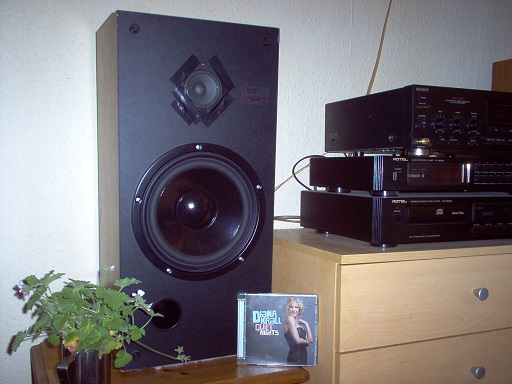
Here done as a regular LR4:
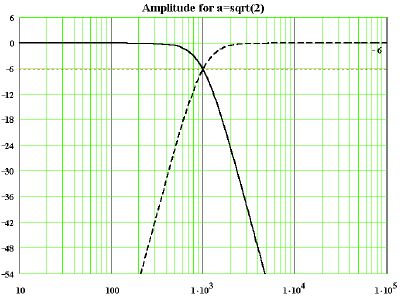
Wiring it out of phase will create a phasey hole in frequency response at crossover. But all is not lost!
If we can find a superb midrange or fullranger, and do some difficult maths, it turns out you can fill the hole!
I won't attempt to create the exact solution, The mid must be in a 90 degree relation with the other two drivers. It only works on axis for overall zero group delay.
Here is what you get when you do a near two-way with a filler driver at midrange:
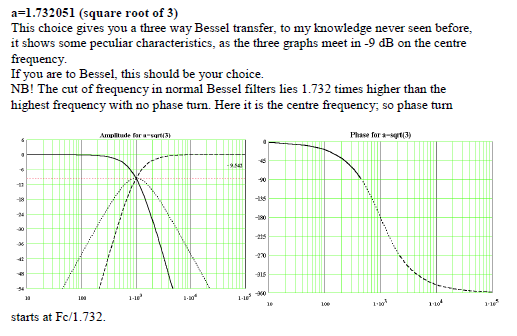
You can improve time delay by upping the midrange level:
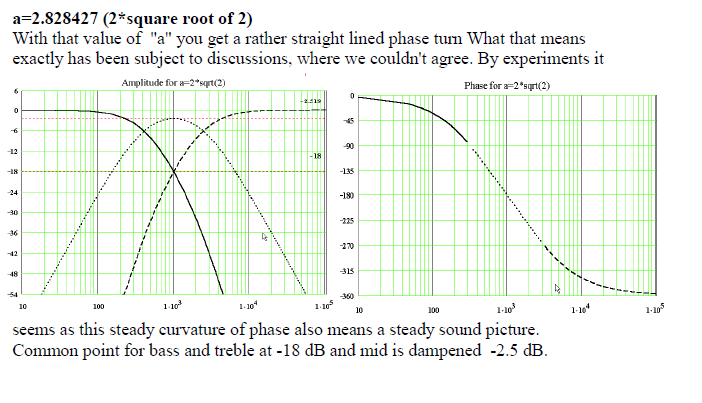
And it starts to look really good when we employ a really wideband midrange:
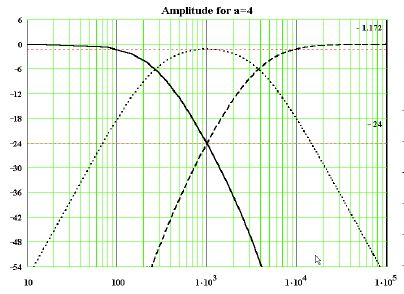
That's not quite the same thing as Uni-Phase.
Here's a simulated group-delay response:
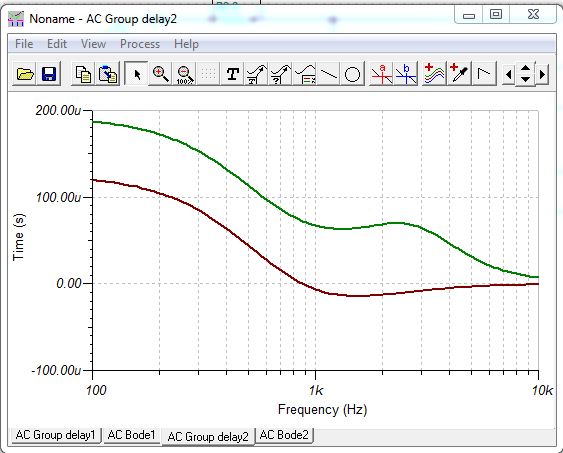
The bass delay is due to bafflestep and bass roll-off. The 3kHz delay is due to the 3KHz. filter. There is an intimate relationship between slopes, phase and group delay.
I am a bit vague on all this stuff, because I am actually not very interested in phase-linear. First order filters are a disaster with two-ways due to distortion on complex classical music. Three ways keep things more under control with shallow slopes if you can find a very good midrange. but really, you get what you get.
Frequency response is just one aspect. Phase coherence is what headphones do, but again just one of many things that might help. And probably tells you nothing about how good a speaker will sound.
A very clever design. Does anyone have a xover schematic of an actual "Uni Phase design"? It seems like it has the advantage of using a 2nd order electrical filter which does not stress out the drivers, but having the advantage of no overall system phase shift.
The "B&O" still fundamentally uses 2nd order filters which have a different time-domain response vs first order filters, therefore the "B&O" will probably "excite" the drivers differently vs. a first order filter and hence the resulting non-linear distortions. Anyway, it's getting a bit too theoretical from here though.
John Kreskovsky probably knows a lot more about all the complex variable filter solutions of B&O "Uni-Phase" than me. The basic idea, IIRC, was to wire up a woofer and a tweeter out of phase. Might as well be one of my 3kHz crossover designs:
Here done as a regular LR4:
Wiring it out of phase will create a phasey hole in frequency response at crossover. But all is not lost!
If we can find a superb midrange or fullranger, and do some difficult maths, it turns out you can fill the hole!
I won't attempt to create the exact solution, The mid must be in a 90 degree relation with the other two drivers. It only works on axis for overall zero group delay.
Here is what you get when you do a near two-way with a filler driver at midrange:
You can improve time delay by upping the midrange level:
And it starts to look really good when we employ a really wideband midrange:
That's not quite the same thing as Uni-Phase.
Here's a simulated group-delay response:
The bass delay is due to bafflestep and bass roll-off. The 3kHz delay is due to the 3KHz. filter. There is an intimate relationship between slopes, phase and group delay.
I am a bit vague on all this stuff, because I am actually not very interested in phase-linear. First order filters are a disaster with two-ways due to distortion on complex classical music. Three ways keep things more under control with shallow slopes if you can find a very good midrange. but really, you get what you get.
Frequency response is just one aspect. Phase coherence is what headphones do, but again just one of many things that might help. And probably tells you nothing about how good a speaker will sound.
I was doing similar in the '90s. At one point I was using your site for inspiration
Here is the problem with the passive crossover approach. There are many ways design speakers with no crossover induced phase distortion which can be implemented passively. Call the transient perfect, phase and time coherent, what ever you like. In the end such speakers are minimum phase systems as the phase response will be uniquely defined by the speaker's amplitude response. You can think of the speaker as a band pass filter with, for example, a high pass cut off of 30 Hz and a low pass cut off of 20k Hz. The phase at low frequency, below the cut off, will approach 90 time the order of the roll off; 2nd order will go to 180 degrees. Similarly, above the high frequency the phase will approach -90 time the order of the roll off; 2nd order will go to -180 degrees. For such a speaker, with the cut off frequencies as indicated above, there will be a region of linear phase, equivalent to a constant time delay, from about 1k extending about 10k. Below 1k phase and group delay will increase. Thus any passive design can never achieve true phase and time coherence, or simply put, true transient accuracy. all that can be done is to eliminate crossover induced time and phase distortion.
Another problem with the passive (or even active analog) approach is evaluation. Certainly measurements can be made and compared to other crossover topologies that are not TP (transient perfect). They can be made on the design axis and look very good by comparison. Off axis? Some time no so good. But the real test is in listening. And that is where the major problem comes it. Every time you change the crossover there are a multitude of things that change, even assuming identically similar axial response. Phase changes, off axis response (polar response) changes, the overlap of the drivers changes. So, if you listen to a speaker with conventional LR crossover and one that has some type of TP crossover you can not conclude, for better or worse, that the change is due only to the TP nature of one of the speakers.
This is were digital come in. Certainly with digital it is possible to implement any of the TP crossover topologies and with much greater accuracy than with analog (active or passive). But that sill leaves one with the problems of differences in polar response and driver overlap, etc. However, there are other advantages of the digital approach. First, the phase response due to the system roll offs can be corrected rendering the speaker linear phase across its entire bandwidth. But this would still leave the polar and driver overlap differences in play.
The real power of the digital approach is to take any system with any crossover and render it TP across its entire bandwidth. At that point the only differences are the phase response and the effect, if any, of the digital processing. This can be evaluated by using different digital processor to see if it makes a differences in listening tests. years ago I went though this process and listened to a variety of speakers with and with out phase correction. I had audiophile friends over to listen and evaluate. Regardless of the source or listeners, the results were always inconclusive, with the exception of one factor: low frequency response. It was only with low frequency content that linear phase seemed to have some repeatable advantage. But even there it wasn't 100% agreed upon. It was that that point I stopped worrying about linear phase crossovers and TP systems. Yes, they produce nice measurements, but audible differences between an LR4 crossover and the same speaker corrected to linear phase just didn't materialize.
To John K...,
Do you happen to have an "analog" version of the Uni-Phase speaker in your link above? I couldn't find the xover schematic in the links provided.
As for DSP, I think the argument will be similar to tubes vs. solid states, or low feedback vs. high-feedback amplifier. DSP aims to achieve a better mathematical solution but there are real world practical issues that ultimately affect the sound. We gain something but give up on something else. Tubes objectively have higher distortion vs solid states but some still prefer tubes. High feedback amplifiers have lower distortion vs low feedback amplifiers or no feedback but people still prefer no feedback amp (See Pass Labs article "Audio, Distortion and Feedback" on page 10). I think the human ears prefer things that may not be intuitive. Anyway, we are getting into areas which people have been arguing about so I doubt there will be any agreement here
At the end, I think it's hard to get "everything". You gain something, you lose something else. It depends on what you prefer. Just like with tubes you gain something but lose on other things - just like with solid states. Just like DSP vs. analog approach.
To say DSP is "better" is missing the point.
Do you happen to have an "analog" version of the Uni-Phase speaker in your link above? I couldn't find the xover schematic in the links provided.
As for DSP, I think the argument will be similar to tubes vs. solid states, or low feedback vs. high-feedback amplifier. DSP aims to achieve a better mathematical solution but there are real world practical issues that ultimately affect the sound. We gain something but give up on something else. Tubes objectively have higher distortion vs solid states but some still prefer tubes. High feedback amplifiers have lower distortion vs low feedback amplifiers or no feedback but people still prefer no feedback amp (See Pass Labs article "Audio, Distortion and Feedback" on page 10). I think the human ears prefer things that may not be intuitive. Anyway, we are getting into areas which people have been arguing about so I doubt there will be any agreement here
Without making any assumption, I suspect you were using DSP to implement different types of filters for comparison? Is it possible the DSP electronics could be the overriding factor? Troels and Zaph both think there is an advantage in lower filter order design. Again, as I said above, this argument will go on and on … I don't expect anyone to agree here.I had audiophile friends over to listen and evaluate. Regardless of the source or listeners, the results were always inconclusive
At the end, I think it's hard to get "everything". You gain something, you lose something else. It depends on what you prefer. Just like with tubes you gain something but lose on other things - just like with solid states. Just like DSP vs. analog approach.
To say DSP is "better" is missing the point.
Last edited:
Well, I think that actually every loudspeaker construction has different "intrinsic limits" up to which different xo types and Fx will alter eg. radiation pattern and lobing (baffle width, interdriver distance, bass cone area).
On contrary to JohnK's friends, I personally can hear difference of my 4ways between LR2 and LR4 xo, on-axis eq'd same and off-axis pretty much same. There is something more natural in the sound of piano's reverb and whole classical orchestra, with LR2. I have strong belief that it comes from less GD (= tighter step response). I can hear difference between LR44 and LR2 on subwoofers too (better stump/attack with LR2). And all this with Minidsp! My friends roll their eyes and are not sure of the difference, but that must be because the difference is not the typical day/night but very subtle and requires some piece, time, accommodation, musicality and cultivation to listen to instruments' coloration.
On contrary to JohnK's friends, I personally can hear difference of my 4ways between LR2 and LR4 xo, on-axis eq'd same and off-axis pretty much same. There is something more natural in the sound of piano's reverb and whole classical orchestra, with LR2. I have strong belief that it comes from less GD (= tighter step response). I can hear difference between LR44 and LR2 on subwoofers too (better stump/attack with LR2). And all this with Minidsp! My friends roll their eyes and are not sure of the difference, but that must be because the difference is not the typical day/night but very subtle and requires some piece, time, accommodation, musicality and cultivation to listen to instruments' coloration.
Last edited:
This can be evaluated by using different digital processor to see if it makes a differences in listening tests. years ago I went though this process and listened to a variety of speakers with and with out phase correction. I had audiophile friends over to listen and evaluate. Regardless of the source or listeners, the results were always inconclusive, with the exception of one factor: low frequency response. It was only with low frequency content that linear phase seemed to have some repeatable advantage. But even there it wasn't 100% agreed upon. It was that that point I stopped worrying about linear phase crossovers and TP systems. Yes, they produce nice measurements, but audible differences between an LR4 crossover and the same speaker corrected to linear phase just didn't materialize.
Pretty much matches my experience on the subject. I did a similar test, both at home and at the local audio club meeting, using a coaxial (synergy horn clone) speaker. At the meeting fewer than 20% said they could detect a difference, and among them there was no real preference for either linear phase or non-linear phase.
FWIW, similar (at home) results with no-(global) feedback amplifiers, comparing both type amps that also had low output impedance and pretty low distortion. Liked the feedback amps a little better at least when played loud, no doubt because they were able to provide more power.
Andy,
It's all there somewhere.
Topologies
http://web.archive.org/web/20060119173146/http://www.geocities.com/kreskovs/TP3-project7.html
Measured compared to simulated filter response.
TP3-project8
Acoustic response of each driver with passive filter in place.
TP3-project9
Picture of the passive figures is shown on this page.
TP3-project14
Juhazi,
I agree that an LR2 will sound different than an LR4. One major difference is the driver overlap through the crossover region. What I was saying is that you can dsp preprocess the input to the LR4 system so that it is linear phase. Then compare listening with the dsp in or out. Neither me nor my friends could tell whether the dsp was in or out of the system with any degree of confidence. The conclusion can only be that nether the phase correction or the dsp had any positive or negative impact on the speaker. I even went to the point of keeping the dsp in the system but changing the dsp from phase correction to just a pass through.
The point of doing this is that all other things, driver overlap, polar response, diffraction.... remain constant. Only phase changes
It's all there somewhere.
Topologies
http://web.archive.org/web/20060119173146/http://www.geocities.com/kreskovs/TP3-project7.html
Measured compared to simulated filter response.
TP3-project8
Acoustic response of each driver with passive filter in place.
TP3-project9
Picture of the passive figures is shown on this page.
TP3-project14
Juhazi,
I agree that an LR2 will sound different than an LR4. One major difference is the driver overlap through the crossover region. What I was saying is that you can dsp preprocess the input to the LR4 system so that it is linear phase. Then compare listening with the dsp in or out. Neither me nor my friends could tell whether the dsp was in or out of the system with any degree of confidence. The conclusion can only be that nether the phase correction or the dsp had any positive or negative impact on the speaker. I even went to the point of keeping the dsp in the system but changing the dsp from phase correction to just a pass through.
The point of doing this is that all other things, driver overlap, polar response, diffraction.... remain constant. Only phase changes
Thank you John K... for the links.
I was intrigued by the B&O Uni-Phase filter and it seems to provide the best of both worlds - having a proper step response, 0 phase shift (at least where it counts), but using LR2 so it does not place a lot of demands on the drivers.
I was then trying to look up to see if Stereophile ever did a review of any B&O but it seems like there are very few reviews of them at least here in the States. The only one I saw was this but it probably was not designed for Uni-Phase based on the measurements.
Bang & Olufsen BeoLab 90 loudspeaker Measurements | Stereophile.com
I was intrigued by the B&O Uni-Phase filter and it seems to provide the best of both worlds - having a proper step response, 0 phase shift (at least where it counts), but using LR2 so it does not place a lot of demands on the drivers.
I was then trying to look up to see if Stereophile ever did a review of any B&O but it seems like there are very few reviews of them at least here in the States. The only one I saw was this but it probably was not designed for Uni-Phase based on the measurements.
Bang & Olufsen BeoLab 90 loudspeaker Measurements | Stereophile.com
Thank you for the comments, JohnK! Yes LR2's wider overlap is an important factor. It has both pros and cons - less GD but often more nonlinearities, more distortion and different off-axis response specially vertically (smoother but because of that more noticable). However in my 4ways these effects were minimal, hardly measurable and I didn't notice tonal balance changes, only sort of timbre effects. Bit like perfectly vs. slightly off/unevenly tuned piano/guitar playing.
I have also tried to do FIR/rePhase correction with minisp 2x4HD, but I didn't learn how to. That would be like your test and a fun learning process, if I have inspiration and time...
I have also tried to do FIR/rePhase correction with minisp 2x4HD, but I didn't learn how to. That would be like your test and a fun learning process, if I have inspiration and time...
As for the debate whether there is a difference in different filter topologies, and whether "phase" is a factor (which can be difficult to visualize), what can better be seen graphically is the overshoot in different filter types. Instead of repeating what I have said, I here quote from John K... website:
In closing I would like to make a few comments about why I believe that transient perfect crossovers are superior to standard crossovers, be they the even ordered LR type of odd order Butterworth. The common argument is that we can not hear phase differences in musical tones. While this continues to be an area of argument between audiophiles and theorists, it remains an unresolved issue. However, perhaps a more relevant issue, and one that may be easier to grasp is that associated with the over shoot and ringing of the impulse response as shown in Figures 8, 9 and 10. For example, ignoring the observation that the tweeter is firing in the wrong direction in Figure 8, clearly there is still the issue of overshoot. The initial response to the impulse is significantly greater than the signal. In the real case there would be some limitation on this due to the limited band width of the tweeter, but never the less, this over shoot would result in excessive SPL levels for the initial rise to a sharp musical tone. This may be perceived as coloration to the sound of such instruments as a piano or other percussion instruments. Ultimately this may be perceived as unnatural or even fatiguing. Obviously, this depends on the sensitivity of the listener to such effects, but I believe that the issue goes beyond simply arguments on the audibility of phase shifts. From my personal experience I have found that among speakers that are relatively equal on all other factors, those with superior transient response prove to sound more natural in the long term when listened to on their design axis.
- Home
- Loudspeakers
- Multi-Way
- An exercise in converting a speaker to time-phase coherent
